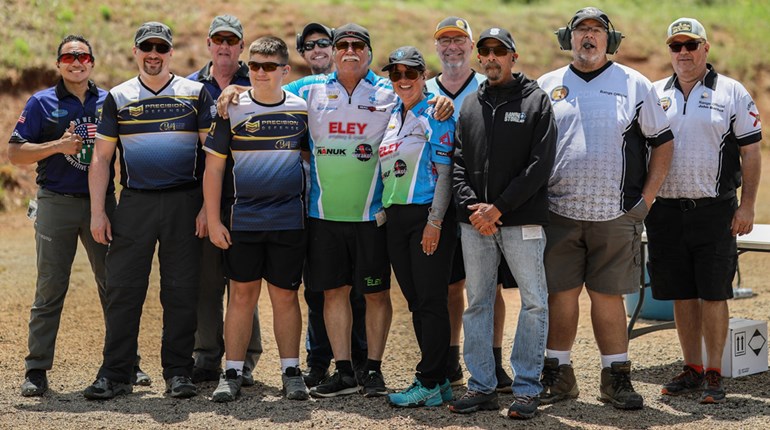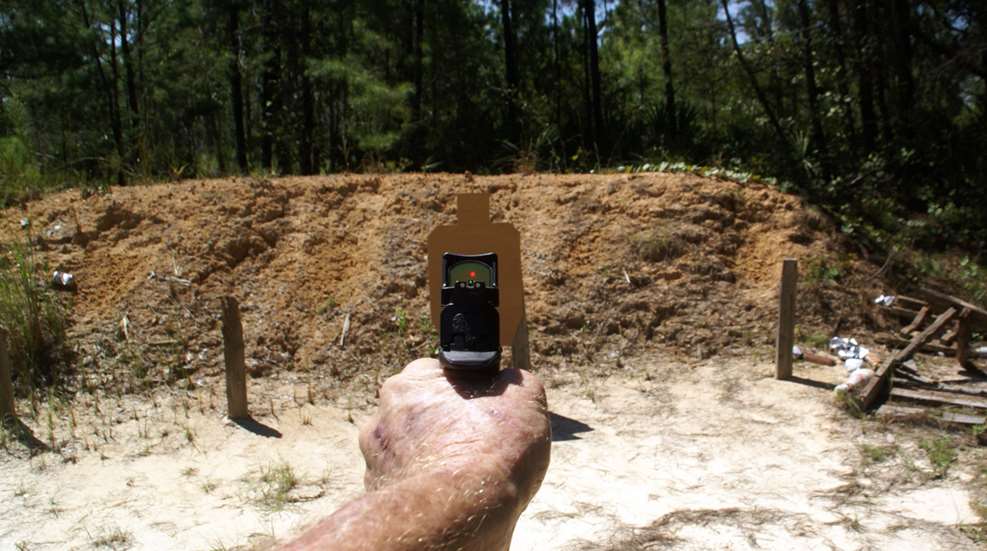
Above: Focusing on the target and letting the dot flow to it is the key to speed with red dot sights. The co-index iron sights on this S&W C.O.R.E. help many shooters, including the author, get that dot where it needs to be quickly.
Red dot sights have a distinct advantage over iron sights: they don’t require the eyes to focus on perfect iron sight alignment while keeping the target within a usable focus. With red dots the single focus is on the target with the dot superimposing itself there. Focus on the target, put the dot where you want the bullet to hit and don’t worry about multiple focus points.
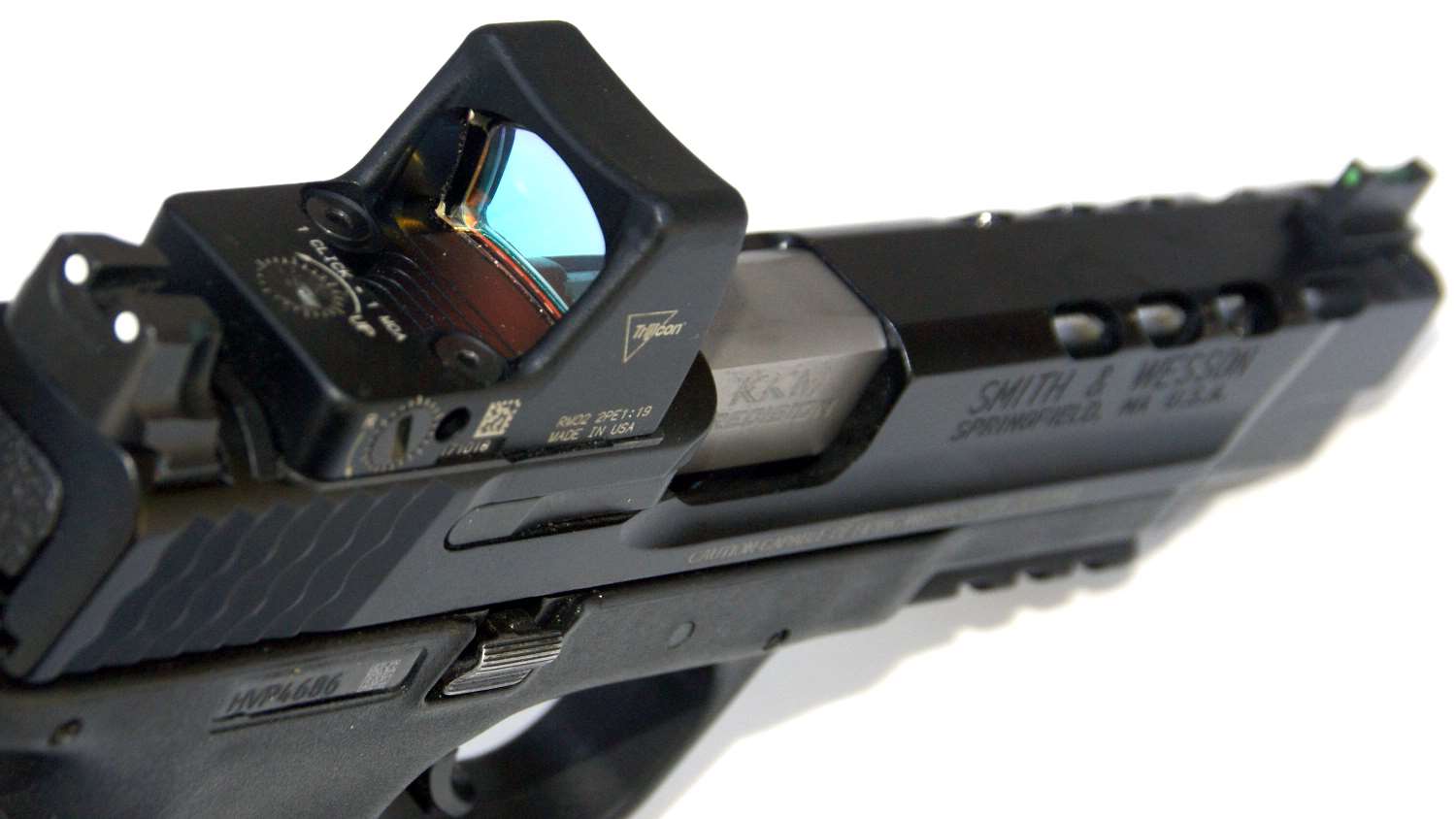
This has extended the careers of many older Precision (Bullseye) shooters who, through the normal aging process, have lost elasticity of focus in their eyes. They have also proven very popular with USPSA/Steel Challenge Open Class shooters. There are now additional options available for their use, including USPSA’s new Carry Optics division. They are a plus for targets beyond 10 yards, and can produce more accurate hits quickly.
It’s not hard to mount a red dot sight on a revolver or semi-auto, whether a tube sight or a compact reflex sight. Shooters also have a large number of options from various manufacturers when choosing a reticule or dot size. Precision shooters often prefer smaller dots (2 or 3 MOA) while action shooters tend to favor larger dots (6 to 12 MOA), or even triangles. Some reflex sights offer an adjustable dot brightness feature and those who shoot on dimly-lit indoor ranges are wise to choose them. Reducing the brightness prevents a massive “dot bloom” in dimmer light.
Regardless of which sight is chosen, the next task is getting zeroed.
Getting Zeroed
Many Action Pistol shooters find that if their iron sights are dead on at 10 yards, they’re good to go. That is not how it works with red dot sights.
The red dot sight axis is higher above the bore than iron sights. Slide-mounted reflex sights are lowest (.75- to 1.00-inch) while frame-mounted sights may be as much as two-inches above the bore. It creates a significant sight axis/bore axis offset in the same manner as AR15 iron sights.
For the bullet to impact on the dot the two different axis have to intersect at some point. Since the bore axis is fixed, that means the sight axis has to point downward to meet it. Before that intersecting point the bullet will impact low, and beyond that point the bullet will impact above the dot. The closer the chosen sight-in distance, the greater the sight axis offset is—and the greater the Point of Impact (POI) difference will be.
I remember a Steel Challenge shooter who showed up with a new Open Class gun that had a rather high frame-mounted reflex sight. It appeared to have almost two-inches of offset. He had just received the gun and only had time to do a quick sight-in at about 12 yards. He was shooting over the top of the 18x24-inch targets at 35 yards with a center dot hold!
This bore/sight offset is not an issue for Precision Pistol shooters because they will have separate sight settings for 15, 25 and 50 yards and the time to make the adjustments before they shoot. Action pistol shooters in USPSA, ICORE, and Steel Challenge don’t have that luxury. They need one sight setting that will accurately handle all the targets in their chosen game. Given the variety of calibers, loads, and mounting options used with dot-equipped guns there is no one formula for the “perfect” zero setting. A 20 to 25 yard zero is normally recommended but sometimes that needs to be fine-tuned.
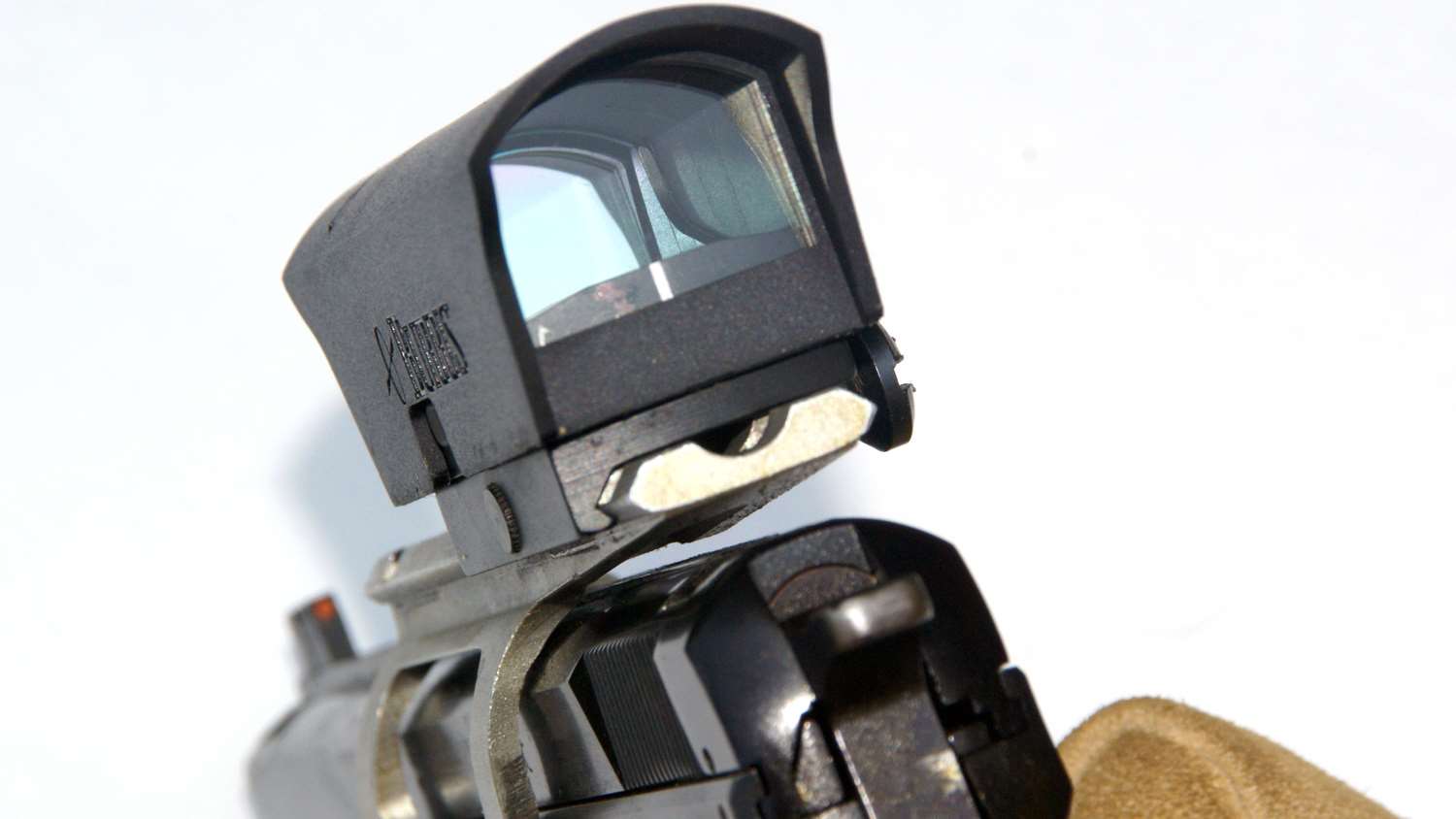
The 9mm S&W C.O.R.E I use in Carry Optics for USPSA/Steel Challenge has a Trijicon RMR sight with a 6.5-MOA dot that sits .75-inches above the bore. When zeroed at the dot center at 25 yards, it’s a couple inches high at 50 and slightly more than an inch low at 7 yards. That’s fine for Steel Challenge, and might look good for USPSA—unless I have to make a tight A-Zone head box shot around a No Shoot target at close range. That one-inch is enough to drop the round into the B-Zone (or the No Shoot) and cost me points I shouldn’t have lost. Instead, I zero it just above the top of the dot at 25 yards. There’s no significant POI change on steel or USPSA targets at 25 to 50 yards, but the round is now less than one-half inch low at 7 yards and closer; allowing a normal dot hold to hit the head box A-Zone.
The Ruger MKII .22LR I use for Steel Challenge has a frame-mounted Burris FastFire III with an 8-MOA dot and about 1.5-inches of offset. I only use the gun for Steel Challenge and since the toughest target there is the 10-inch plate at 20 yards on Accelerator, I zero the gun dead on, dot center, at 20 yards. The POI shift is inconsequential for all the other targets. Different objectives may require a different zero setting. It pays to look at impact points both near and far with a dot and reach the best compromise on zero distance for the game being played. The next challenge is …
Where’s Waldo?
For shooters who start with the gun in hand (precision and rimfire action shooters) the proper wrist angle grip can be assumed in advance, with the dot centered in the window. From there it’s just a matter of maintaining the proper grip angle to present the dot to the target. That changes for those who start from the holster.
Many iron sight shooters focus on the target, draw and present the gun with the front sight slightly elevated, shift to sight focus, drop the front sight into the rear sight (with whatever level of alignment is needed for target distance) and start shooting. That becomes almost automatic and is easy because the iron sights and target are within the same large ‘view window’ and minor corrections can be subconsciously made.
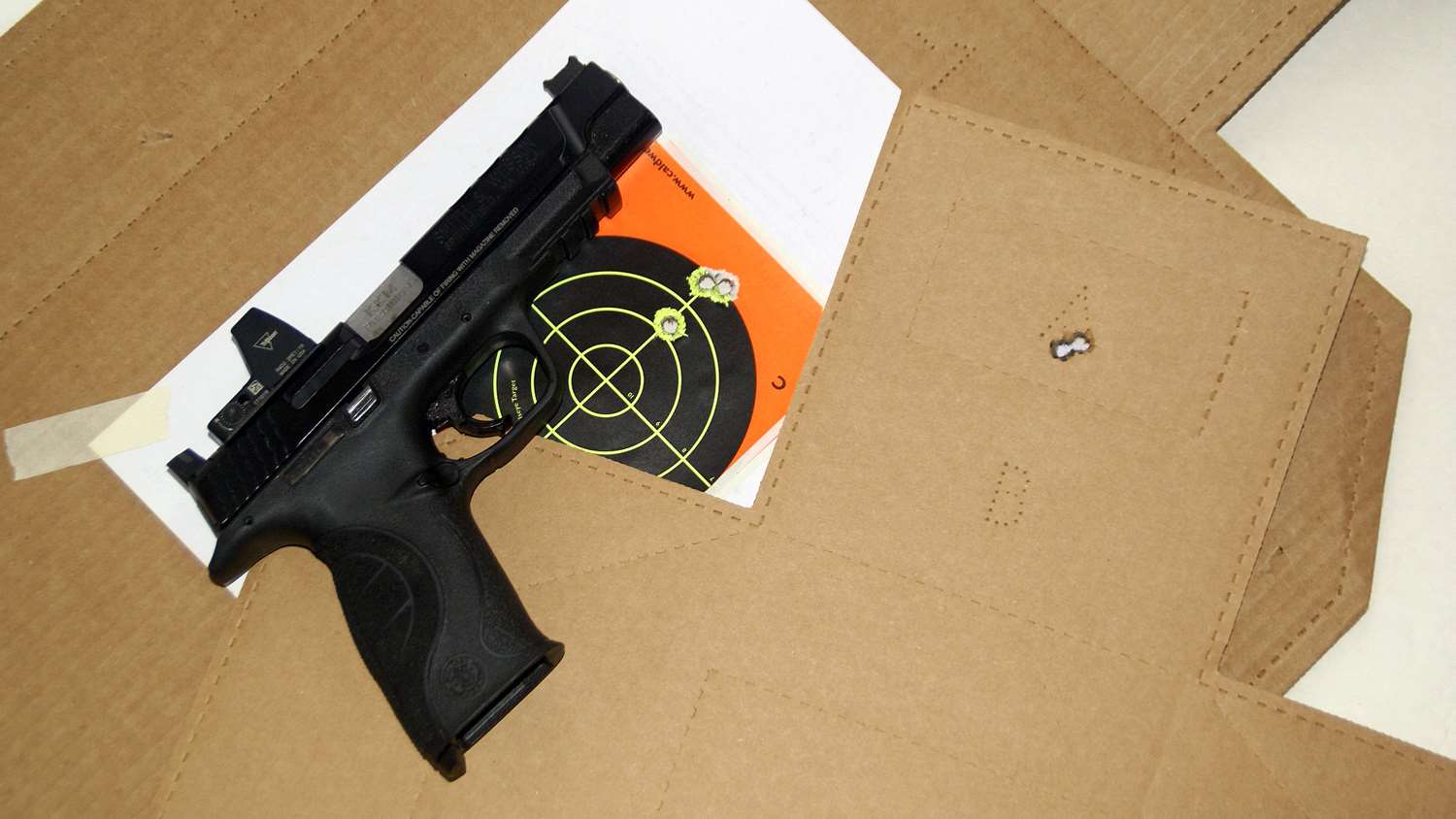
Finding the dot through the smaller reflex sight window requires a more precise draw stroke/presentation. With ‘target focus’ the dot has to appear on the target as the gun is presented. A sloppy draw stroke results in “Where’s Waldo?” and precious time spent twisting the gun around, up and down, to bring the dot into view. Many shooters find they need to present the gun on the draw with the shooting hand wrist cocked slightly forward of their normal iron sight draw stroke. Some shooters find that guns with co-witness iron sights, visible through the reflex window, allow them their normal draw and speeds up the learning curve to finding the dot faster.
It takes practice and repetition. An excellent place to start is with dry/draw practice in the house. Tape a four-inch square of white paper on a contrasting background ... focus the eyes on the square ... then draw the gun to put the dot on the square. Repetitions are required.
Once the dot becomes consistently centered where the eyes are looking, move to the range. An 8x11-inch sheet of copy paper makes an excellent target at 25 yards. The grip angle can be refined while running one-shot drills from the holster. After that, Transition Drills can develop the ability to move quickly between targets while maintaining focus on the dot.
Once an Action Pistol shooter has their dot-equipped gun moving as quickly as their iron sight gun, they will have successfully transitioned to the dot, and their score sheet will look a lot better!
















